Small Number and the Old Canoe-Gitxsan
AM TS’UUSXWM G̲ABI GANHL LOG̲OM M’AL
XSTINS G̲A̲BIHL X̲KUULXW’S TS’UUSXWM G̲ABI II G̲AN WILA HA’TAKW’T
SA TUN DIM II’T HLIISANHL’S YE’E’T TS’AK’M LILIGET II SA’GOOTXW’T DIM MA’OS’T DIP TS’UUSXWM G̲ABI G̲ANHL ANSIPSIIPINSXW’T GOOHL GYALK̲
LUGWIL AMA SA II SIM TS’ATXWHL HLOX̲S AHL GW0OYIM II Y’AG̲A GUL DIIT LAX TSEEHL AKS
AM TS’UUSXWM G̲ABI GANHL LOG̲OM M’AL
Written by Veselin Jungic & Mark MacLean
Gitxsan translation by: Jeanne Harris, Catherine Blackstock, and Barbara Harris Sennott
Illustrated by Simon Roy, Victoria, BC
TRADUCCIÓN
Links
Transcript
AM TS’UUSXWM G̲ABI GANHL LOG̲OM M’AL
XSTINS G̲A̲BIHL X̲KUULXW’S TS’UUSXWM G̲ABI II G̲AN WILA HA’TAKW’T
Small Number is a five year-old boy who gets into a lot of mischief.
SIL JOKED TS’IITS’T GANHL NII YE’E’T II AP W’ODIIT ‘NIIT II NEEDII A’L’AX DIIT LOOT TS’AA G̲AL ‘MALU ‘NIT
He lives with his Grandma and Grandpa, who patiently put up with his antics most of the time.
SA TUN DIM II’T HLIISANHL’S YE’E’T TS’AK’M LILIGET II SA’GOOTXW’T DIM MA’OS’T DIP TS’UUSXWM G̲ABI G̲ANHL ANSIPSIIPINSXW’T GOOHL GYALK̲
Today, Grandpa needs to finish carving a feast dish and decides that Small Number should go out and play with his friends.
LUGWIL AMA SA II SIM TS’ATXWHL HLOX̲S AHL GW0OYIM II Y’AG̲A GUL DIIT LAX TSEEHL AKS
It is a beautiful, sunny, spring day, and they (the boys) run down to play near the water.
LIP LIGI AGWIHL GY’AA DIIT IIT HO JAP DIIT SII MA’OS GANHL TS’UUSXWM G̲ABI GANT W’II T’AABEEK̲’XW DIM X̲STAAHL LIGI’T NAA DIM ANT M’ATSHL LO’OP WAGYT N’AGWIT
Everything they see sparks a new game (play), and Small Number’s friend Big Circle says the winner will be whoever throws the stone farthest.
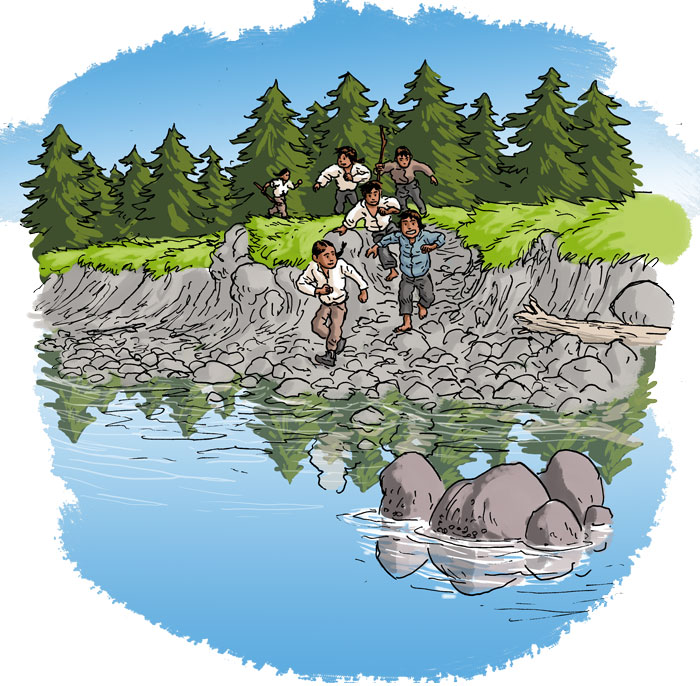
II SA’GOOTXWS WIIT’AABEEK’XW DIM’T GYA’AHL NAA DIM ANT AL’PA M’ATSHL LO’OP W’GYT N’AGWIT TSIM AKS
Big Circle suggests they see who can make a stone skip the farthest on the surface of the water.
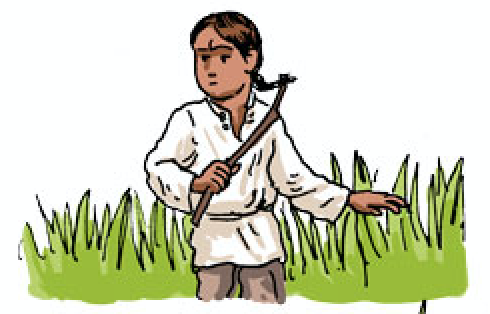
WILAAK KUBA TILX’WM GYAT SGIDIM HOX DIIT YAHLXW’M TABEEKWIM LO’OP II DIM ‘NAKW DIM WIL G̲OSHL YAHLXW’M LO’OP
The boys quickly learn that for a stone to go far it needs to be smooth, flat, and oval shaped.
II’T GI’IS TS’UUSXWM G̲ABI TABEEKWIM YAHLXW’M LO’OP
Small Number wanders far along the shore looking for a winning stone. (smooth, flat, and oval)
II YEET LAX HABASXW II DEEX’S TS’UUSXWM G̲ABI II’T YATS’HL T’IMG̲ES’T LAX LOGAM ‘MAL TSIM HABASXW
He scrambles through tall grass and trips (over something), falling headfirst into an old canoe hidden (in the grass).
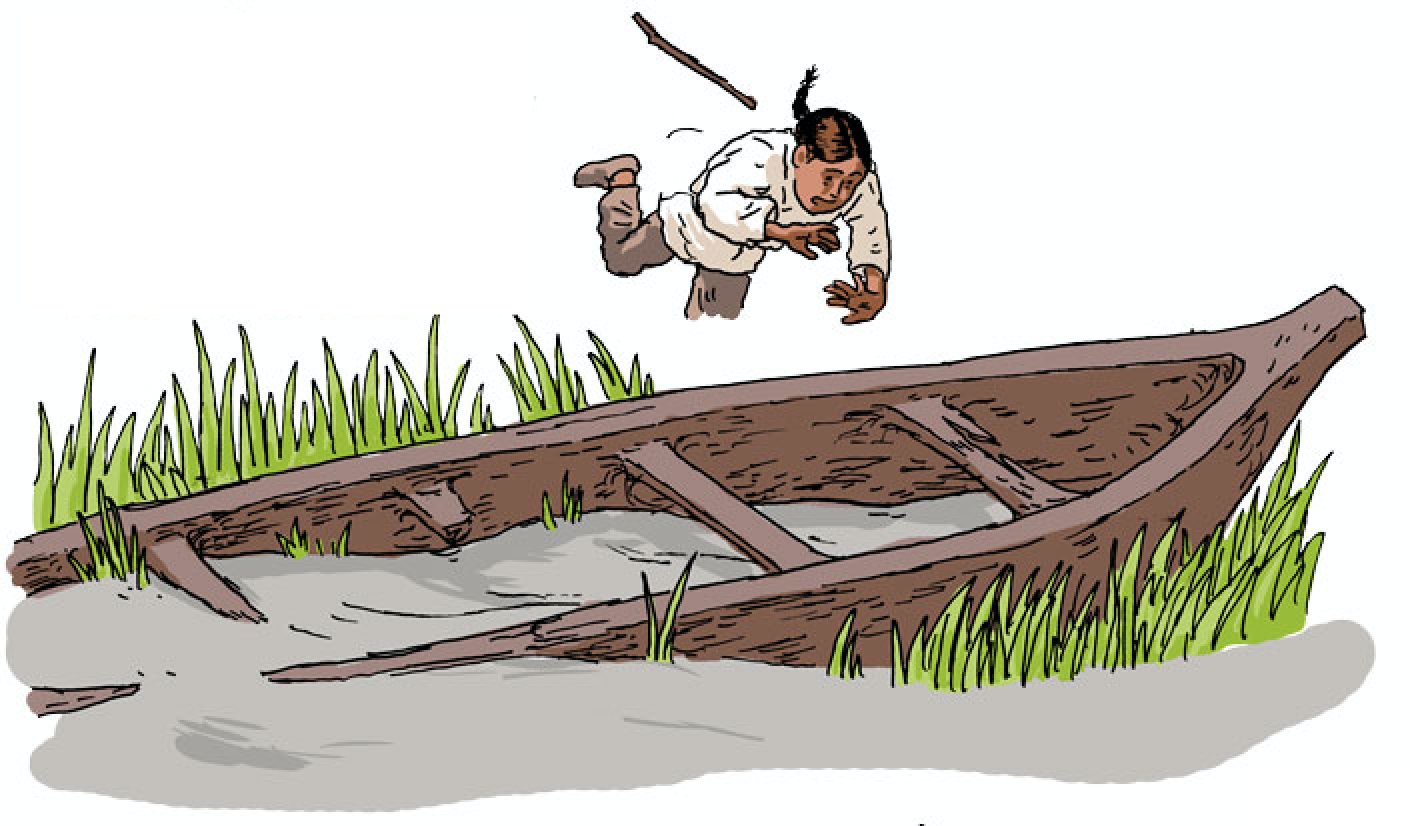
HETXW’T TS’UUSXWM G̲ABI HLIBA’L’T DITHL HUPX̲’T AHL YUKW’T GY’AHL LOGUM ‘MAL
Small Number stands up, rubbing his forehead as he looks around at the canoe.
TSAA LIGI SIIPXWHL T’IMGES’T II AP LUU AMHL G̲OOT’T WILT W’AHL LOGUM ‘MAL II’T EETXWHL ANSIPSIIPINXW’T II G̲UN G̲UL DIIT
Even though his head hurts, he is very excited at his discovery (of the old canoe) and he calls out to his friends, who come running.
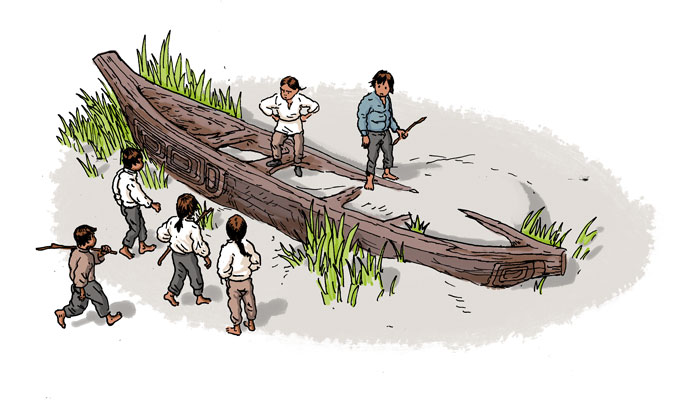
II GUN LITXWHL GYAT IIT DAS DIITHL II SAAM YA’HLXW’HL LOGUM ‘MAL II SIM YAHLXW’T AHL AN’ON DIIT
The boys stand around the canoe, running their Hands along its smooth shape.
WIHL AP LIGI WII ‘TIS IDYHL LOGUM ‘MAL
It looks very old and very big to them.
GIDAG̲AS AM TS’UUSXWM G̲ABI HINDAHL GABIHL GYAT DIM NII WANIT LAX ‘MAL?
Small Number asks, “How many people do you think it could hold (in the canoe)?”
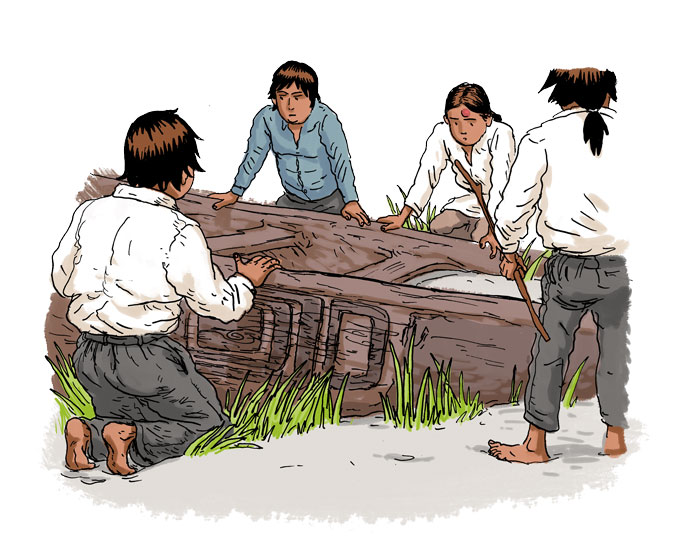
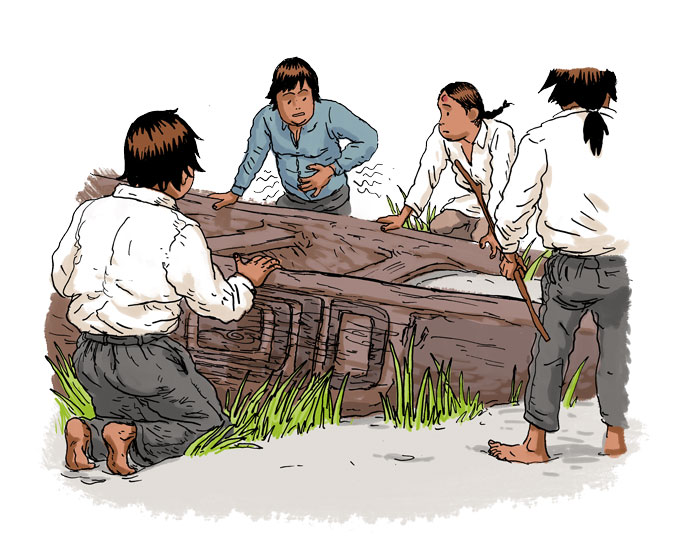
GIDAG̲AS WII TA’BEEKWXW HINDAHL GABIHL K’UUHL JIS WIT JAP DIITHL ‘MAL GI?
Big Circle asks, “How many generations (years) ago was it built?”
‘TAGIHL KUBA ‘TILXW WILT MATS DIIT YALXW’A LO’OP G̲AL T’ISHL ALALGYAX DIIT AHL WILA WIHL ‘MAL II’T NAA DIM ANT HOOX’T?
The boys forget their previous game (of throwing the rock) and spend a long time talking about the canoe and who might have used it.
YUKHL ALALGYAX DIIT II DALHL G̲ALOOST’S WII TA’BEEKWXW ‘XWDAX NII’Y. DII! TOOKW’IM ANSIPSIIPINSXW’Y
As they are talking, Big Circle’s tummy starts to growl. “I’m hungry. Let’s go eat.” he says to his friends.
WILAYHL HLO’GOTSUUHL ‘TIHLXWM IIXWT WIL HOTI HU DAX DAA II ‘WALG̲A G̲UL DIIT GOOHL GALTSAP
The other boys realize they are hungry too, and they all run back to the village.
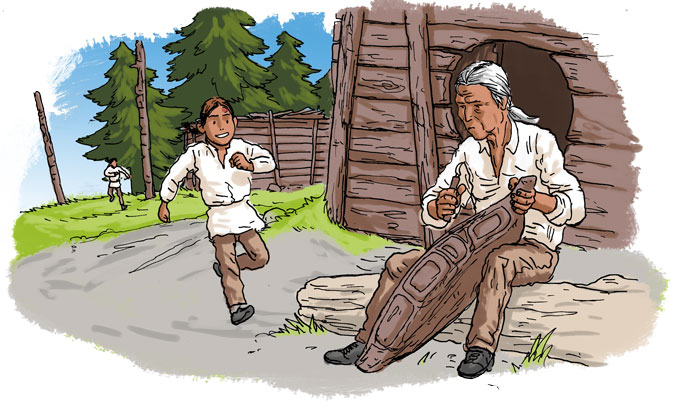
BAX’T TS’UUSXWM G̲ABI GOOHL NIYE’E’T, YUKW’T JAPHL NO’OHL’M G̲AN
Small Number races home, where Grandpa is carving the surface of a huge wooden dish.
YUKWHL G̲ELXWS TS’UUSXWM G̲ABI II MIIN GYA’LAASXWS NIYE’E’T II’T GYA’A WIL MU’KWHL HUPX̲’S TS’UUSXWM G̲ABI GIDAG̲AS YE’E “HINDAHL ‘WIN?!”
Small Number is shouting excitedly and Grandpa looks up. “What happened?!” Grandpa asks.
‘TAGIS TS’UUSXWM G̲ABI WILT G̲OGANHL HUPX̲’T II SITAA’MA DIM’T MAHLIHL AS YEE’T WILT ‘WAHL LOGAM ‘MAL
Small Number has forgotten that he bumped his head and starts to tell Grandpa about finding the (old) canoe:

‘WA’YHL LOGAM ‘MAL LAX XSIIP! II HANI G̲OOT’T JI LIGI XSTINS WIL KYAP DA GIL BIL X̲KUUHL’T
“I found an old canoe down on the beach! It must be at least a hundred years old!”
MUMK̲’T YE’E. WILA’YHL ‘MAL TUUST G̲YAA AYEEHL ‘MAL TUUST GO’OHL G̲AL’TSAP’M JABIS ‘NIGWOOD’Y GANHL BAGA DILI’THL HU WAKXW’T
Grandpa smiles. “I know that canoe. It was once the fastest canoe in our village. It was built by my father and two of his brothers.”
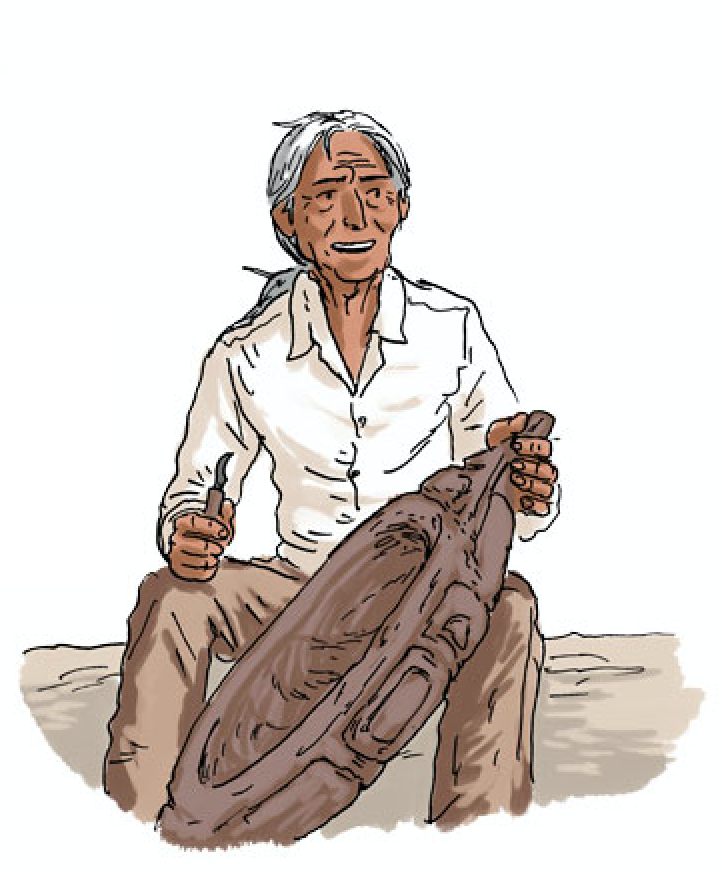
HLO’OHL G̲OOTS YE’E II HET, WALK̲A ‘NITHL HLGUUHL’M II UX’T ANT WILAX GYAHL G̲AN
Grandpa proudly continues, “All the sons of my grandfather were known as great wood carvers.”
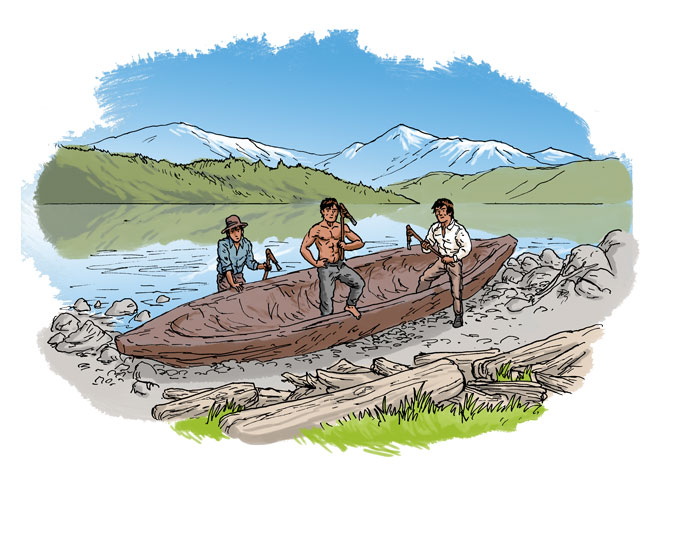
WILAYANHL GWILA’L’T G̲YADIM G̲AN LITXWIT HLA KOOGHL WII ‘NAKW’M WILP AA? NIBIBII’Y ANT JAPHL TAX̲ ‘NITSXWHL GYADIM G̲AN
“You know those three old totem poles in front of the longhouse? Each of them (totem poles) was built by one of my uncles.”
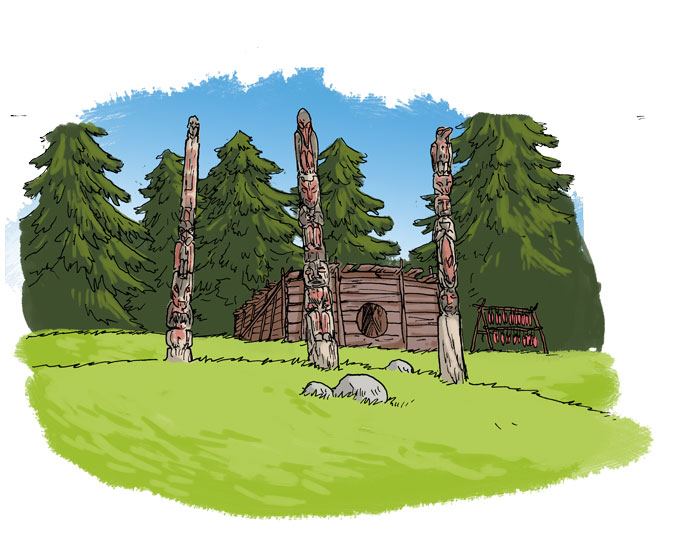
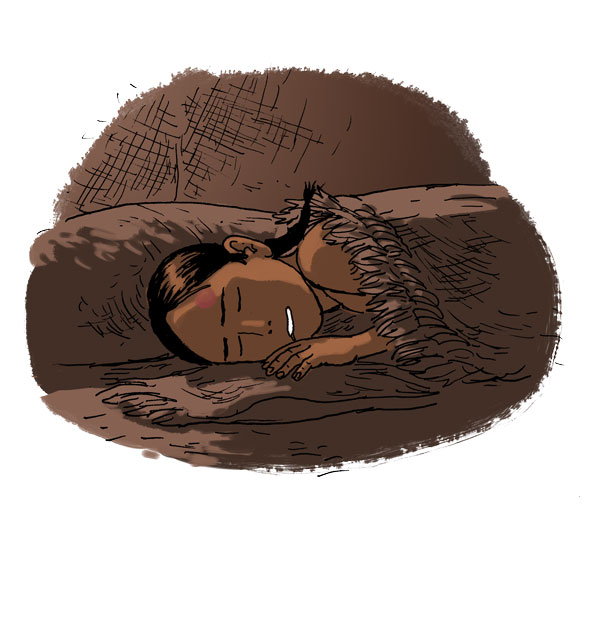
HLA GOOKXW’M DIM WOKS, TS’UUSXWM G̲ABI AHL YUXWSA, II’T TIL X̲HOOTXW’T DIM “HASAGY NIM JAPHL ‘MAL GANHL GYAYHL G̲AN WILA WIS DIP NI’YE’E’TXW’Y SKIDIM GITAGASXW’Y AS YE’E ‘TAAHLAK HINDAHL GABIHL WAK’S NIGWOOT’T?”
That evening, just before falling asleep, Small Number thought, “I’d like to build canoes and totem poles just like my ancestors. I have to ask Grandpa tomorrow how many brothers his father had. Two, three, four, five or more…”
HINDAHL: HINDA G̲AN WIHL HANI G̲OOT’S TS’UUSXWM G̲ABIHL NIYE’E’TXW’T GANHL WAK’T JI LIGI BAG̲ADIL, GWILUN, TX̲ALPX̲DUL, XWSDINSUL?
Question: Why did Small Number think that his great-grandpa might have two, three, four, five or more brothers?
Credits
Written by Veselin Jungic, SFU, and Mark MacLean, UBC
Gitxsan narration by Barbara Harris, Jeanne Harris and Catherine Blackstock of the Gitxsan Nation
Voice: Jeanne Harris of the Gitxsan Nation
Illustrator: Simon Roy, Victoria, BC
Sound: Jeanne Harris of the Gitxsan Nation
Music: Catherine Blackstock of the Gitxsan Nation
Animation: Andy Gavel, Vancouver, BC
Producer: Veselin Jungic, Simon Fraser University
Director: Andy Gavel, Vancouver, BC, and Aidan Wright, Victoria, BC
Special Thanks To:
- Tom Archibald, Simon Fraser University
- Gary George of the Wet’suwet’en Nation
- Peter Jacobs of the Squamish Nation
- Ozren Jungic, University of Oxford
- Kwosel of the Seabird Island First Nation
- Kwelaxtelot of the Seabird Island First Nation
- Susan Russell, Simon Fraser University
- Erin Tait of the Nisga'a Nation
- Department of Mathematics, Simon Fraser University
- Faculty of Science, Simon Fraser University
- The IRMACS Centre, Simon Fraser University
- Office for Aboriginal Peoples, Simon Fraser University
- Pacific Institute For Mathematical Sciences